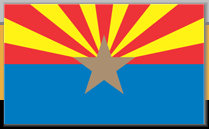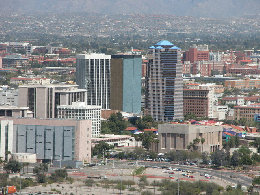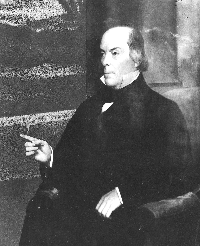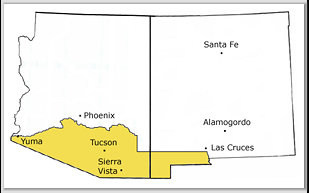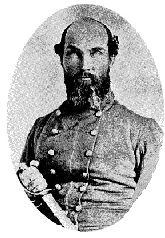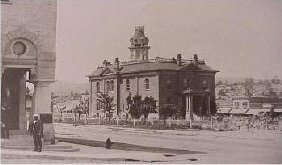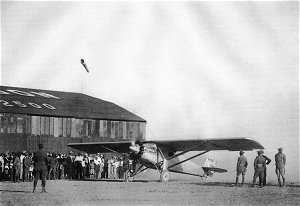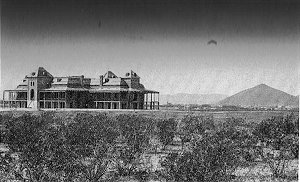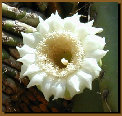Tucson, Arizona
The
Old Pueblo
History of
36 people lived in Tucson in 1804. By 1819 there were 62. Fray Pedro Antonio de Arriquibar was chaplain of the fort and took the census.
The town was bounded roughly by today's Washington and Pennington streets and Main and Church Avenues. The population was mostly Spanish,
Mexicans, and Native Americans who made their living raising crops and livestock.
On September 16, 1810, the rebel leader
Miguel Hidalgo,
the Creole parish priest of the small town of Dolores, Mexico
decided to strike out for independence by marching on Mexico City. Thus
began the
Mexican-Spanish war. After a decade of war the Mexican revolutionaries eventually won and Mexico gained it's independence
from Spain.
On August 24, 1821, representatives of the Spanish crown and Iturbide signed the
Treaty of Córdoba, which recognized Mexican
independence. The settlers of the Tucson Presidio were now citizens of Mexico and part of the State of Vieja California.
Mexican-Spanish War
Mexico War of Independence
Mexican-American War
In 1835, Texas declared independence from Mexico and Santa Anna led his army in to crush the rebellion. In 1846, the ideology of Manifest
Destiny and the occupation of disputed territory dispute over the United States annexation of Texas led the United States to initiate
the
Mexican-American War.
Shortly after the war began in 1846, Tucson was occupied by Army Captain Philip St. George Cooke and
the Mormon Battalion, raising the U.S. flag over the town for the first time. The road the battalion built to Tucson became a major
route for travelers to and from California.
The U.S. occupied Mexico City and forced the newly founded Mexican Republic to give up
its northern half, including the later Arizona. The
Treaty of Guadalupe Hidalgo (1848) ended the Mexican-American war and specified
that the U.S. pay Mexico the sum of $15 million in compensation for lands transferred to the U.S. extending the boundaries of the
United States west to the Pacific Ocean. The treaty not withstanding, Tucson was now within an area disputed by the U.S. and Mexico
and it's status won't be clear until the Gadsden Purchase clarifies the borders.
The Gadsden Purchase
After the end of the Mexican-American War in 1848, the border disputes between the United States and Mexico remained unsettled. In
addition, the U.S. government was looking for a southern route for a transcontinental railroad. In an effort to resolve the lingering
border disputes and provide for the railroad route, the U.S. negotiated the
Gadsden Purchase with Mexico. On December 30, 1853, U.S.
Minister to Mexico James Gadsden and Mexican President Antonio López de Santa Anna agreed on the price of $10 million for the Gadsden
land. With the treaty signing, Arizona became part of U.S. (New Mexico) territory.
It wasn't until the Gadsden Purchase (also known
as the Treaty of La Mesilla), effective in June 1854, that Tucson was officially part of America. Troops didn't show up until March
1856 to take possession. By that time the town had been growing due to the additional commerce brought in by people on their way to
the gold strikes in the west. In 1849, the California Gold Rush led as many as 50,000 miners through the region. In 1857, the area
became a stage stop for the Overland Stage lines between San Diego and San Antonio. This was a well-used route by travelers. Tucson
became a major supply center during the civil war both for soldiers and for miners.
The Civil War
At the outbreak of the Civil War, sentiment in the territory was in
favor of the Confederacy. Territorial secession conventions were
called at Mesilla and Tucson in March 16, 1861 that adopted an Ordinance of Secession that declared itself independent of the United
States and established the provisional Confederate Territory of Arizona.
Captain Sherod Hunter rode in with 200 mounted Texans on
February 28, 1862, to take the town for the Confederacy, there was no resistance. Union supporters left and the confederate flag was
hoisted. The rebel forces soon got word, though, that Colonel James H. Carleton, was coming east from California with his 1,500 man
California Column and would be arriving first in Yuma, then Tucson. There was a
skirmish at Picacho Pass April 15, 1862 north of town
between an advance guard of the Column and scouts from the rebel force. This was the only Civil War battle to be fought in Arizona.
Colonel (later General) Carelton and the California Volunteers
recaptured Tucson in June 1862 and drove out Confederate forces, putting
Arizona back under Union control, making Tucson now part of the U.S. again (New Mexico Territory).
Arizona Territory
In 1864 when
Arizona became a separate territory (to the chagrin of New Mexico territory), Tucson, the most populated and important
trading center in Arizona, was denied the territorial capital because Anglo-Americans were fearful that the already powerful and influential
Mexican-Americans would dominate local and territorial politics.
The first capital was at
Fort Whipple outside of Prescott, followed
by Prescott itself, in the northern Union-controlled area. In 1867, following the end of the Civil War, the capital was moved to Tucson
where it remained for the years 1867 to 1877. In 1877 it was moved back to Prescott and in 1889 it was finally moved to Phoenix, where
it remains.
The first military telegraph line hooked Tucson with the rest of the world in 1873.
The Railroad
On March 20, 1880, the first Southern Pacific Railroad train
arrived bringing the prospect of growth and prosperity for the territory.
When the railroad arrived, Tucson was the largest settlement between the West Coast and San Antonio with a population approaching
8,000. With the availability of "eastern" building materials and techniques, it was gradually transformed from a dusty, adobe "pueblo",
to a modern U. S. city.
The railroad brought wealthy Anglo entrepreneurs who invested and dominated in mining, ranching, retailing
and agriculture. Goods and supplies from American suppliers were brought from the railroad for competition with Mexican trade.
The
Sisters of St. Joseph opened St. Mary's Hospital the year the railroad arrived. Electric lighting arrived in 1883 and in 1885, the
territorial legislature authorized the state university for Tucson.
The University of Arizona
The precursor to the University of Arizona, the Arizona Territorial University was opened in 1891 on land donated by a saloon keeper and a pair of gamblers, and $25,000 provided by the territorial government. The local politicians were disappointed at the appropriation, instead hoping for money to build the territory's mental hospital.
Classes met for the first time in 1891 with 32 students in Old Main, the first building constructed on campus, and still in use to this day
The 20th Century
By the time it became the
48th state in 1912, Arizona was famous for the sunny climate and dry air that made it ideal as a healthful
spot where people could visit and settle. Tucson became a destination for tuberculosis patients from all over the world
Around 1900,
the US Veterans Administration had begun construction on the present Veterans Hospital. Many veterans who had been gassed in World
War I and were in need of respiratory therapy began coming to Tucson at this time, also due to the clean dry air.
In 1920 Tucson became
the first city in the nation to have a municipal airport (at the location of the present-day Davis-Monthan AFB). Charles
Lindbergh
visited the Tucson Airfield once. He was on a tour of the United States that started at Mitchel Field, Long Island, New York, July
20, 1927, and ended at Mitchel Field on October 23, 1927. His tour was a celebration of his recent transatlantic success. Lindbergh
landed in Tucson on the afternoon of September 23rd flying the "Spirit of St. Louis". After landing, he spoke to a crowd of about
5,000 people on the University of Arizona campus. On the following day, October 24, 1927, at 7:50 a.m. Lindbergh took to the skies
to continue his somewhat grueling victory tour.
By 1950 Tucson's population had reached 120,000 and by 1960 it nearly doubled to 220,000.
The City and Pima County officially recognized the city's history by adopting historic district ordinances in 1972.
Tucson became
the 33rd largest U.S. city in 1990 as its population topped 400,000.
As of July 1, 2006, a Census Bureau estimate puts the city's
population at 518,956 making it currently the 32nd largest city in the U.S., and with a metropolitan area population of 946,362 it
is the 52nd largest metropolitan area in the U.S.











This website was created and is maintained by:
Philip J. June
Tucson, AZ
This website was first created
and published on 11.24.07;
Last update was 11.24.07
James Gadsden (1788-1858)
U.S. Minister to Mexico
The Gadsden Purchase
Governor John R. Baylor
Confederate Territory of Arizona
Capitol Building in Prescott - 1910
Southern Pacific Depot - 1907
Congress Street Paving - 1913
Lindbergh and "Spirit of St. Louis"
in Tucson - 1927
Unfinished Old Main at UA - 1890







